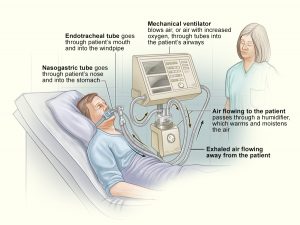The Physiology of a Mechanically Delivered Breath
Once someone is intubated and attached to a ventilator, the lungs are now a “sealed system.” This means that whatever air is pushed out of the ventilator has nowhere else to go except into the lungs (inhalation), and air that leaves the lungs has nowhere to go except for back to the ventilator (exhalation).
Object Lesson

As you learned in Chapter 1, lungs act like balloons. Now, imagine a balloon sealed to the end of a straw. When you blow air through the straw, it must go into the balloon. The balloon will inflate when the pressure you blow is hard enough to overcome the strength of the rubber. If you fill the balloon up and stop blowing, air will come rushing back into
your mouth as the balloon relaxes.
In the case of mechanical ventilation, inspiration occurs by air being pushed from the ventilator into the lungs. Inspiration continues until the breath has been fully given—either what is set by the ventilator (mandatory/control breaths) or based on the patient demand (spontaneous breaths). Exhalation remains a passive process. When full, the inflated lungs have a higher pressure than the outside atmosphere once the driving pressure stops from the ventilator—and, as you remember from Chapter 1, air always flows from higher to lower pressure. During exhalation, a valve opens and the ventilator allows the air to vent through a filter out to atmosphere—the full alveoli will be higher pressure than the atmosphere, similar to the concept of spontaneous breathing where during exhalation, the pressure in the lungs is higher than the pressure at the mouth (Pmo). Air flows from high to low pressure from the lungs back to the ventilator.
Apply Your Learning
Refer to the following diagram of a patient who requires a mechanical ventilator. Can you understand why the mechanical ventilator is a sealed system? It is also a good idea to start becoming familiar with the parts of the ventilator. You’ll learn a lot more about them in future chapters.

Media Attributions
- Ventilator © National Institute of Health is licensed under a Public Domain license

